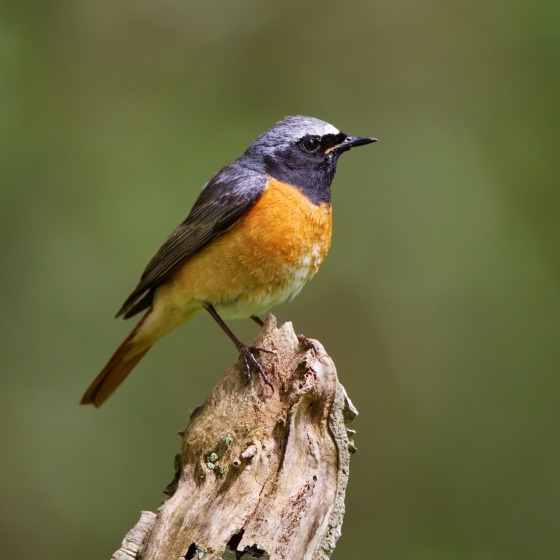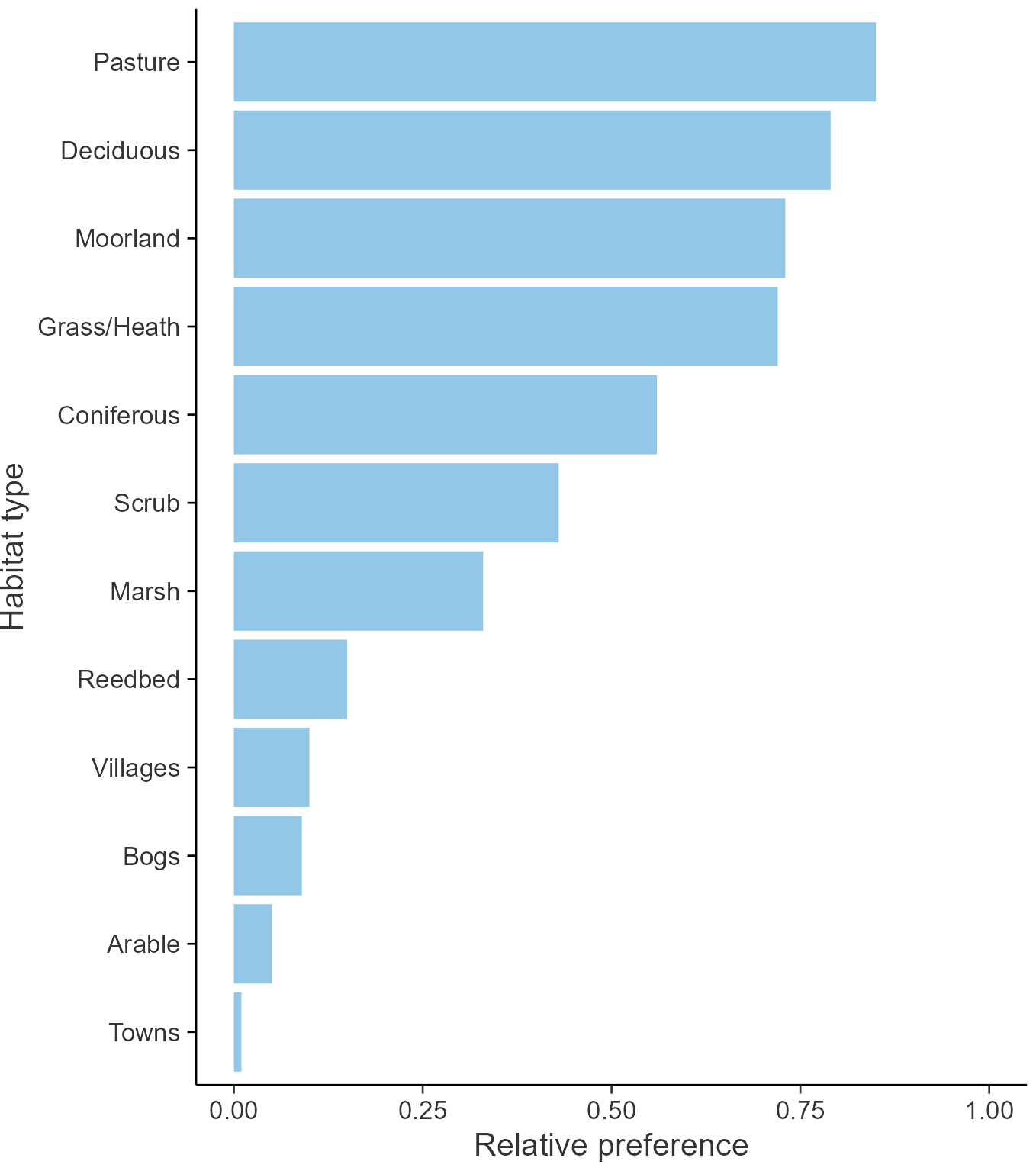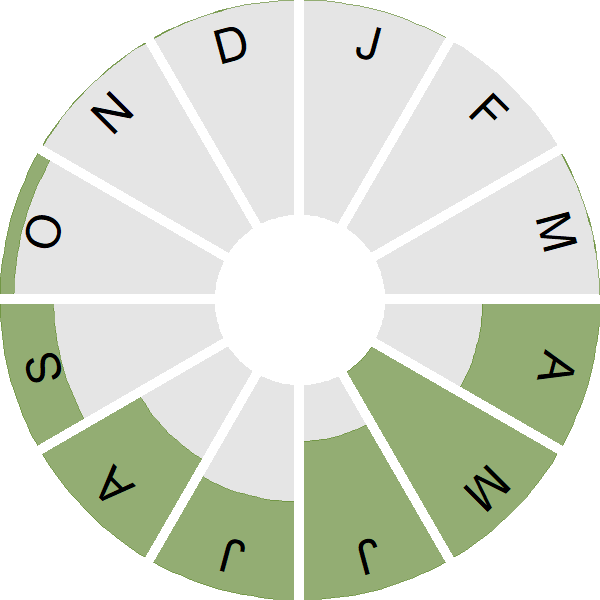Redstart

Introduction
A bird of deciduous woodland, the Redstart gets its name from the colour of its tail, 'start' being an old colloquial name for tail.
The Redstart is a summer visitor to Britain & Ireland, arriving in April and departing through September and October for its wintering location in trans-Saharan Africa. The male is a striking bird, pinky-red below with a black face, silvery-white forehead, grey back and striking red tail, whilst the female has pale orangey-red underparts, pale brownish upperparts and slightly duller tail.
Redstarts can be found breeding across the UK, although their strongholds are in the west. However, this species is only a rare breeder in Ireland. UK numbers declined in the late-1960s due to drought in this species' Sahelian wintering grounds. Numbers subsequently recovered, and now fluctuate.
- Our Trends Explorer gives you the latest insight into how this species' population is changing.

Key Stats
Identification
ID Videos
This section features BTO training videos headlining this species, or featuring it as a potential confusion species.
Redstarts
Songs and Calls
Song:
Status and Trends
Conservation Status
Population Change
A sharp decline in the late 1960s and early 1970s was thought to be due to severe drought conditions in the Sahel wintering area in Africa (Marchant et al. 1990). There was a 20% loss of occupied 10-km squares in Britain between 1968-72 and 1988-91 (Gibbons et al. 1993). A recovery in population size began in the mid 1970s and appears to have been sustained subsequently, although with some setbacks. Range, meanwhile, has contracted further, especially in the lowlands (Balmer et al. 2013). The European trend is described as being a 'moderate increase', although the change since 1980 is shown as only +8%, with the trend graph suggesting declines in the early 1980s have since been reversed (PECBMS: PECBMS 2020a>).
Distribution
The Redstart is a rare and perhaps overlooked annual breeder in Ireland. Breeding Redstarts are absent from the Channel Islands, Isle of Man, Northern Isles and most Hebridean Islands, from which suitable wooded habitat is lacking. Otherwise, they have a wide and patchy distribution in western and northern Britain, with highest densities in the wooded uplands of Wales, northern England and, to lesser extent, southern Scotland. Small pockets of distribution remain in southern England, mostly associated with heathland.
Occupied 10-km squares in UK
2007/08–10/11
or view it on Bird Atlas Mapstore.
2008–11
or view it on Bird Atlas Mapstore.
European Distribution Map
Distribution Change
The Redstart's British breeding range has contracted by 31% since the 1968–72 Breeding Atlas. Losses are most apparent in the English lowlands and in Scotland, through the Central Belt and on the northern and western fringes of the range. In the 1988–91 Breeding Atlas, it was noted that Redstarts were increasing in core areas and decreasing in the range margins; these trends have continued.
Change in occupied 10-km squares in the UK
from 1981–84 to 2007–11
or view it on Bird Atlas Mapstore.
from 1968–72 to 2008–11
or view it on Bird Atlas Mapstore.
Seasonality
Redstart is a summer visitor, arriving through April. Birds gradually depart in early autumn when we also receive passage migrants from the continent.
Weekly pattern of occurrence
The graph shows when the species is present in the UK, with taller bars indicating a higher likelihood of encountering the species in appropriate regions and habitats.

Habitats
Breeding season habitats
Relative frequency by habitat
The graph shows the habitats occupied in the breeding season, with the most utilised habitats shown at the top. Bars of similar size indicate the species is equally likely to be recorded in those habitats.

Movement
Britain & Ireland movement
Foreign locations of birds ringed or recovered in Britain & Ireland
Dots show the foreign destinations of birds ringed in Britain & Ireland, and the origins of birds ringed overseas that were subsequently recaptured, resighted or found dead in Britain & Ireland. Dot colours indicate the time of year that the species was present at the location.
- Winter (Nov-Feb)
- Spring (Mar-Apr)
- Summer (May-Jul)
- Autumn (Aug-Oct)

European movements
EuroBirdPortal uses birdwatcher's records, such as those logged in BirdTrack to map the flows of birds as they arrive and depart Europe. See maps for this species here.
The Eurasian-African Migration Atlas shows movements of individual birds ringed or recovered in Europe. See maps for this species here.
Biology
Productivity and Nesting
Nesting timing
Egg measurements
Clutch Size
Incubation
Fledging
Survival and Longevity
Survival is shown as the proportion of birds surviving from one year to the next and is derived from bird ringing data. It can also be used to estimate how long birds typically live.
View number ringed each year in the Online Ringing Report.
Lifespan
Survival of adults
Biometrics
Wing length and body weights are from live birds (source).
Wing length
Body weight
Ring Size
Classification, names and codes
Classification and Codes
- Order: Passeriformes
- Family: Muscicapidae
- Scientific name: Phoenicurus phoenicurus
- Authority: Linnaeus, 1758
- BTO 2-letter code: RT
- BTO 5-letter code: REDST
- Euring code number: 11220
Alternate species names
- Catalan: cotxa cua-roja
- Czech: rehek zahradní
- Danish: Rødstjert
- Dutch: Gekraagde Roodstaart
- Estonian: lepalind e. aed-lepalind
- Finnish: leppälintu
- French: Rougequeue à front blanc
- Gaelic: Earr-dearg
- German: Gartenrotschwanz
- Hungarian: kerti rozsdafarkú
- Icelandic: Garðaskotta
- Irish: Earrdheargán
- Italian: Codirosso
- Latvian: erickinš
- Lithuanian: paprastoji raudonuodege
- Norwegian: Rødstjert
- Polish: pleszka (zwyczajna)
- Portuguese: rabirruivo-de-testa-branca
- Slovak: žltochvost hôrny
- Slovenian: pogorelcek
- Spanish: Colirrojo real
- Swedish: rödstjärt
- Welsh: Tingoch
Research
Causes of Change and Solutions
Causes of change
The sharp decline in the late 1960s and early 1970s was thought to be due to severe drought conditions in the Sahel wintering area in Africa (Marchant et al. 1990). A recovery in population size began in the mid 1970s. This increase has been associated with steeply improving numbers of fledglings per breeding attempt and progressively earlier laying dates. The trend towards earlier laying can be partly explained by recent climate change (Crick & Sparks 1999), and is in line with an advance of 12 days in the arrival dates of Redstart in the UK, between the 1960s and 2000s ( Newson et al. 2016). Mallord et al. (2016) found no evidence that changes in woodland structure affected populations in six study areas in the west of the UK.
Further information on causes of change
No further information is available.
Information about conservation actions
The Redstart has been increasing since the 1970s and hence is not currently a cause of conservation concern, although there has been a decrease over the last five years. The driver of change may be improved productivity although this is uncertain.
A central European study and experiment found that areas of habitat with sparse (short) vegetation and bare ground were important within Redstart territories, by making prey more easily accessible (Martinez et al. 2010), hence providing more open habitat and providing areas of short vegetation (e.g. through mowing) may benefit this species. However, it should be noted that Mallord et al. (2016) found no evidence that changes to woodland structure had affected populations in the west of the UK. Note also that providing more open habitat for Redstart could potentially also negatively affect several other woodland specialists whose declines may be at least partly related to the loss of woodland understorey (e.g. Woodcock, Nightingale, Wood Warbler, Willow Tit, Marsh Tit).
Publications (1)
Temperature sensitivity of breeding phenology and reproductive output of the Common Redstart (Phoenicurus phoenicurus)
Author: Lonero, I., Eddowes, M.J., Burgess, M.D., Pearce-Higgins, J.W. & Phillimore, A.B.
Published: 2024
One of the most obvious ways in which birds have responded to climate change is by shifting the timing of their breeding and migration. In spring, many long-distance migratory species are now arriving earlier than in the past, and most species are also nesting earlier than then used to, particularly in warmer years. But has this led to a mismatch in the timing of the breeding season and the peak availability of key food resources for breeding birds and their young, leading to a reduction in breeding success and eventual population declines?
20.11.24
Papers

More Evidence
More evidence from Conservation Evidence.com
Partners
Citing BirdFacts
If you wish to cite particular content in this page (e.g. a specific value) it is best to use the original sources as linked in the page. For a more general citation of the whole page please use: BTO (20XX) BirdFacts Species: profiles of birds occurring in the United Kingdom. BTO, Thetford (www.bto.org/birdfacts, accessed on xx/xx/xxxx).

